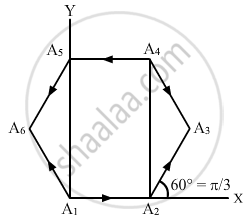Advertisements
Advertisements
Question
Test if the following equation is dimensionally correct:
\[h = \frac{2S cos\theta}{\text{ prg }},\]
where h = height, S = surface tension, ρ = density, I = moment of interia.
Solution
\[h = \frac{2S \cos \theta}{\text{ prg }}\]
Height, [h] = [L]
Surface Tension,
\[\left[ S \right] = \frac{\left[ F \right]}{\left[ L \right]} = \frac{\left[ {MLT}^{- 2} \right]}{\left[ L \right]} = \left[ {MT}^{- 2} \right]\]
Density,
\[\left[ \rho \right] = \frac{\left[ M \right]}{\left[ I \right]} = \left[ {ML}^{- 3} T^0 \right]\]
Radius, [r] = [L], [g]= [LT−2]
Now,
\[\frac{2\left[ S \right]\cos \theta}{\left[ \rho \right]\left[ r \right]\left[ g \right]} = \frac{\left[ {MT}^{- 2} \right]}{\left[ {ML}^{- 3} T^0 \right] \left[ L \right] \left[ {LT}^{- 2} \right]} = \left[ M^0 L^1 T^0 \right] = \left[ L \right]\]
Since the dimensions of both sides are the same, the equation is dimensionally correct.
APPEARS IN
RELATED QUESTIONS
What are the dimensions of volume of a cube of edge a.
What are the dimensions of the ratio of the volume of a cube of edge a to the volume of a sphere of radius a?
If two quantities have same dimensions, do they represent same physical content?
Find the dimensions of Planck's constant h from the equation E = hv where E is the energy and v is the frequency.
Test if the following equation is dimensionally correct:
\[V = \frac{\pi P r^4 t}{8 \eta l}\]
where v = frequency, P = pressure, η = coefficient of viscosity.
Is it possible to add two vectors of unequal magnitudes and get zero? Is it possible to add three vectors of equal magnitudes and get zero?
Can you add two vectors representing physical quantities having different dimensions? Can you multiply two vectors representing physical quantities having different dimensions?
Let ε1 and ε2 be the angles made by \[\vec{A}\] and -\[\vec{A}\] with the positive X-axis. Show that tan ε1 = tan ε2. Thus, giving tan ε does not uniquely determine the direction of \[\vec{A}\].
Which of the sets given below may represent the magnitudes of three vectors adding to zero?
The component of a vector is
The radius of a circle is stated as 2.12 cm. Its area should be written as
A situation may be described by using different sets coordinate axes having different orientation. Which the following do not depended on the orientation of the axis?
(a) the value of a scalar
(b) component of a vector
(c) a vector
(d) the magnitude of a vector.
The x-component of the resultant of several vectors
(a) is equal to the sum of the x-components of the vectors of the vectors
(b) may be smaller than the sum of the magnitudes of the vectors
(c) may be greater than the sum of the magnitudes of the vectors
(d) may be equal to the sum of the magnitudes of the vectors.
The magnitude of the vector product of two vectors \[\left| \vec{A} \right|\] and \[\left| \vec{B} \right|\] may be
(a) greater than AB
(b) equal to AB
(c) less than AB
(d) equal to zero.
A spy report about a suspected car reads as follows. "The car moved 2.00 km towards east, made a perpendicular left turn, ran for 500 m, made a perpendicular right turn, ran for 4.00 km and stopped". Find the displacement of the car.
Let A1 A2 A3 A4 A5 A6 A1 be a regular hexagon. Write the x-components of the vectors represented by the six sides taken in order. Use the fact the resultant of these six vectors is zero, to prove that
cos 0 + cos π/3 + cos 2π/3 + cos 3π/3 + cos 4π/3 + cos 5π/3 = 0.
Use the known cosine values to verify the result.

Prove that \[\vec{A} . \left( \vec{A} \times \vec{B} \right) = 0\].
Give an example for which \[\vec{A} \cdot \vec{B} = \vec{C} \cdot \vec{B} \text{ but } \vec{A} \neq \vec{C}\].
High speed moving particles are studied under
